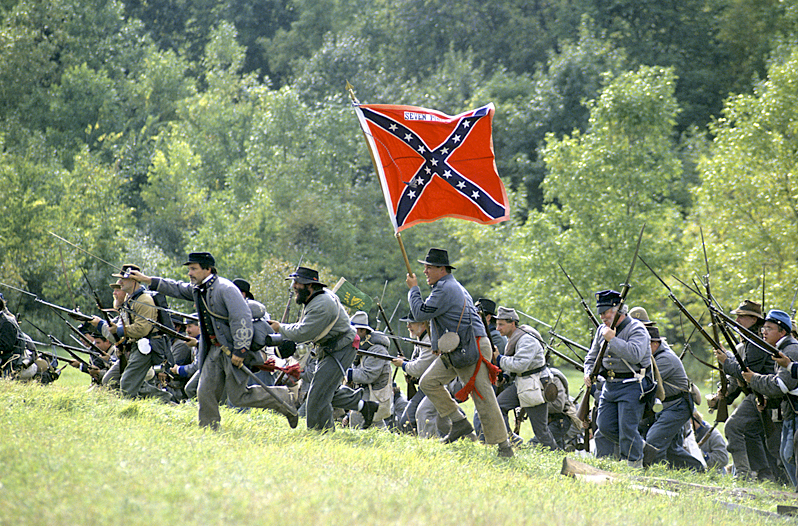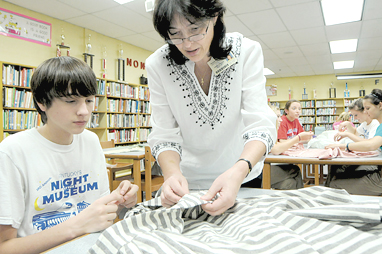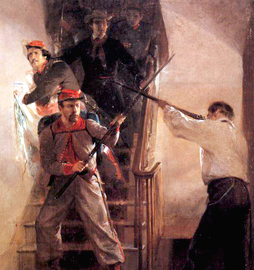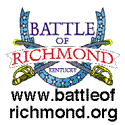‘Nice job’
Richmond eighth-grader Ella Martin tries on the top part of a
Civil War-type dress she sewed in a social studies class conducted by
Clark-Moores teacher Sharon Graves. Emily Burns, Battle of Richmond
volunteer, checks the fit. See story about Graves.
– Nancy Taggart, Richmond Register
|
‘Stitch it here’
Sharon Graves, Battle of Richmond Living History coordinator, assists
Dylan Ingram with sewing his shirt. Students in Graves’ social studies
classes make the clothing as part of their Civil War learning experience.
– Nancy Taggart, Richmond Register
|
|
‘Why you…’
A Union re-enactor fires upon a Confederate
raider who wounded his comrade (foreground)
in the “Battle for the Gold” at the Civil War
Drama and Train Robbery in Versailles.
The event has been conducted for more than
15 years and is scheduled again Sept. 3-4.
See story.
|
First death
Artist Alonzo Chappel painted his impression
of the first Union Officer killed during the
Civil War. Col. Elmer Ellsworth was shot after
removing a Confederate flag from a lodging
house in Alexandria, Va., in May 1861.
See Briefs.
|
Called to fire
A Civil War bugler also knew how to shoot,
as shown in this photo at a Camp Wildcat
re-enactment. Union forces won this battle
as they did in the actual conflict that took place
Oct. 21, 1861. Wildcat will be observing
the 150th anniversary of the battle Oct. 14-16.
|
|
|
Mill Springs honored for restoration
of battlefield’s West-Metcalfe House
A house that provided sanctuary for wounded soldiers at the Battle of Mill Springs has won a Historic Preservation Award for its battlefield association. Read more
‘Simpsonville Slaughter’ one of
state’s saddest Civil War memories
In January 1865, a company of black soldiers was assigned the task of driving 900 head of cattle from their base at Camp Nelson in Jessamine County to a railhead near Louisville. From there, the cattle would travel south on the L&N Railroad to Nashville to provide food for hungry Union troops. Read more
Fayette estate honored
Waveland is Kentucky’s example
of plantation life during Civil War
A historic Kentucky plantation that became a Commonwealth showplace was honored in late June.
Waveland, a southern Fayette County estate that exemplifies plantation life in Kentucky in the 19th century, had a stone monument unveiled honoring the family that built it and the slaves who worked there. One side of the six-foot-tall marker lists the names of Bryan family members who established the plantation in the late 1700s. The other side lists 19 known slaves whose labor made Waveland a Kentucky showplace.
Read more
Part two of two
Civil War soldier wasn’t much different
from distant grandson in Afghanistan
Civil War soldiers, of course, did have some spare time.
In off-duty hours, the men especially enjoyed the game of baseball, which was just becoming widely popular. Card games went on day and night. Soldiers seemed addicted to gambling, although the activity was considered sinful by others. Many soldiers discarded their playing cards as they marched into combat. To be killed with these cards on their person might jeopardize one's eternal destiny. Read more
Making Civil War clothing just part
of hands-on learning for these students
At a recent Battle of Richmond Living History Program, a woman asked one of Sharon Graves’ students where she got her Civil War dress.
“I made it,” the student smiled. “We make all our clothes at school in our social studies class about the Civil War.” Read more
Kentucky’s Civil War leaders…
An ill temper and distrust of superiors
led to downfall of Union Gen. Harrow
Union Brig. Gen. William Harrow began the Civil War as a major, but was named a brigadier general in April 1863 after applying directly to President Abraham Lincoln.
However, an ill temper and an inability to work well with superiors led him to resign from the military in April 1865. Read more
Civil War train robbery
Confederates keep trying, but Union
always wins in ‘Battle for the Gold’
The gold-carrying train suddenly slows and comes to a halt as Union soldiers quickly disembark.
“What’s going on?” someone questions. A look out the window provides the answer. Read more
|
|
|
|
Rebel Yell…
‘If you heard it and weren't scared,
that means you never heard it’
“If you cross the scream of a scalded wildcat with a Comanche war whoop, you’ve got it,” according to a grizzled Confederate re-enactor.
That’s a Kentuckian’s description of the Rebel Yell, a sound that struck fear in the hearts of Union soldiers and a battle cry that fed adrenalin into the charge of Southern troops. Read more
Battle of Richmond, Cleburne promoted
development of sharpshooter tactics
The origin of the term “sharpshooter” is somewhat clouded.
A common misconception is that the term came from the Civil War sharpshooter units who were equipped with the Sharp’s rifles. Sharpshooter techniques, however, were employed by guerillas during the Revolutionary War. Later, the term was used in early nineteenth-century military records describing the tactics of skilled marksmen firing from concealment and at long range.
Read more
Book review
‘Cry Uncle’ a moving, human story
about a war ‘that ain’t fair for nobody’
Civil War accounts are filled with stories of families divided and brother against brother, but Cry Uncle, Sumbody has an interesting twist. It’s a tale of family sacrifices, imprisonment and survival, all based on an actual diary kept by a Union foot soldier. Read more
Racked by disease, reportedly haunted,
Camp Beauregard now just a monument
Long gone and largely forgotten, Camp Beauregard now is identified by a stone monument covering a mass grave.
But, from September 1861 to March 1862, it was a bustling Civil War camp inhabited by some 6,000 Confederate soldiers whose purpose was to protect the right flank of their Western Kentucky garrison at Columbus as well as the railroad from Paducah to Memphis. Read more
Union group established Decoration Day
forerunner of modern Memorial Day
Three years after the Civil War ended (May 1868), the Grand Army of the Republic, composed of former Union soldiers and sailors, established Decoration Day as a time for the nation to decorate the graves of the war dead with flowers.
The organization’s Maj. Gen. John A. Logan declared it should be held on May 30. Read more
American Civil War special for Germans
as historical event ‘worth remembering’
Germany is one of those European countries that traditionally observes the American Civil War. The question is, WHY?
A primary reason is that some 200,000 who had German roots fought in the War Between the States. And, unlike its World Wars, that’s a history Germans feel is worth remembering. Read more
News in brief ...
Seyfrit honored for efforts
at Battle of Richmond
Madison County’s Historic Properties Director Phillip Seyfrit has been awarded the Kentucky Museum and Heritage Alliance’s Pinnacle Award for work he has done in regards to the Battle of Richmond Visitors Center and the preservation efforts at the Battle of Richmond. Read more
|
|
|
















